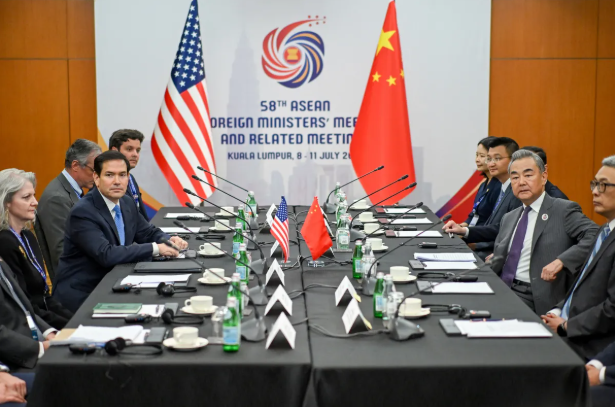Six months into his second term, Trump has softened his campaign rhetoric, no longer emphasizing the huge trade deficit with China and the resulting job losses. This more conciliatory stance contrasts sharply with his threats to other trading partners that he would devastate their economies with high tariffs.
Trump is now focused on reaching a purchase agreement with Beijing similar to the one he achieved in his first term, and is pursuing quick results rather than addressing the root causes of the trade imbalance. In the first half of this year, China’s exports flourished and its trade surplus reached a record high.
On Tuesday, the US president said that he would “fight with China in a very friendly way”.
Some people say that in meetings with his staff, Trump is often the least hawkish voice in the room.
Insiders say Trump’s capricious strategy and his tough policies of reneging on promises have worried decision-makers within his administration and external advisers. This week, there is even more concern that the red lines previously drawn by the US with China are now negotiable.
The decision to once again allow Nvidia to sell its lower-tech H20 chips, which are focused on the Chinese market (despite previous statements by several senior officials that this would not be considered), has overturned the government’s own declared policy of keeping the most critical US technologies out of Beijing’s hands.
Last month, when pressed by senators, US Treasury Secretary Scott Bessent cited water control measures as evidence of the government’s tough stance towards China, as senators were concerned that the US might trade advanced semiconductors for rare earth minerals from this Asian country.
Insiders said that although the US still requires approval for such exports – former President Joe Biden refused to implement this restriction – some Trump administration officials privately opposed granting licenses, claiming that this would only boost the morale of China’s leading technology enterprises.
Others successfully argued that allowing Nvidia to compete with Huawei on its own turf is crucial to winning the artificial intelligence race with China. People familiar with the matter said that the view advocated by Nvidia CEO Jensen Huang has gained support within the government.
A government spokesperson said that Trump has the final say on all trade decisions. White House spokesperson Kush Desai said that the president “has always been committed to creating a fair competitive environment for American workers and industries, and the government has been in productive discussions with all of our trade partners.”
To further ease the tense situation, US officials are preparing to postpone the August 12 deadline, when US tariffs on China will quickly return to 145% after the 90-day truce ends. Bessenett hinted in an interview with Bloomberg Television this week that the deadline is flexible.
A person familiar with the matter said the tariff truce period might be extended for another three months. Meanwhile, Trump is imposing tariffs on other countries, including its major allies, and threatening to take more actions against industries such as pharmaceuticals and semiconductors.
Rubio, once one of the Senate’s most hawkish figures on China, said he had a “very constructive and positive” meeting with Chinese Foreign Minister Wang Yi on Friday.

On Wednesday, Trump praised China’s measures to strengthen the control of chemicals used in the manufacture of fentanyl. This is one of the measures taken by the US president after imposing a 20% tariff on China to promote the circulation of fentanyl.
“China has been providing help,” Trump told reporters. “I mean, the fentanyl problem has been bad for many years. But since I came here, we are having conversations with them and they are making significant progress.”
The softening of Trump’s attitude towards China has led to internal divisions within his advisory team. According to informed sources, some members of Trump’s trade team hope to take a tough stance against Beijing and privately promise that export controls will never be part of the trade negotiations.
However, during the trade talks held in London last month, US Commerce Secretary Howard Lutnick openly stated that the recent export controls – officially explained as being for national security reasons – were also intended to “irritate” Beijing. This week, he, along with Bessenet and David Sacks, the White House’s AI and cryptocurrency affairs chief, directly said that allowing the sale of some less advanced Nvidia chips to China is indeed part of the ongoing trade negotiations.


